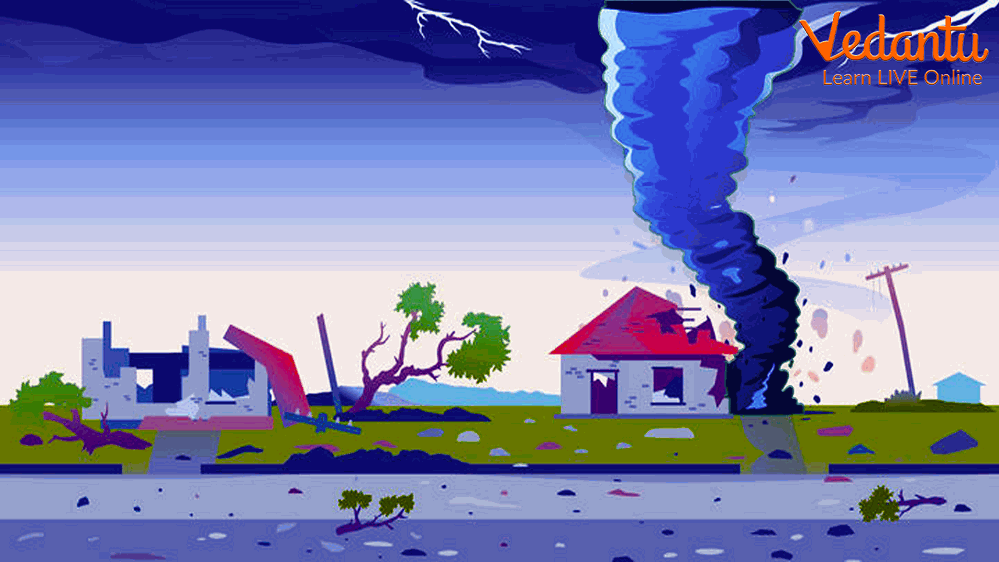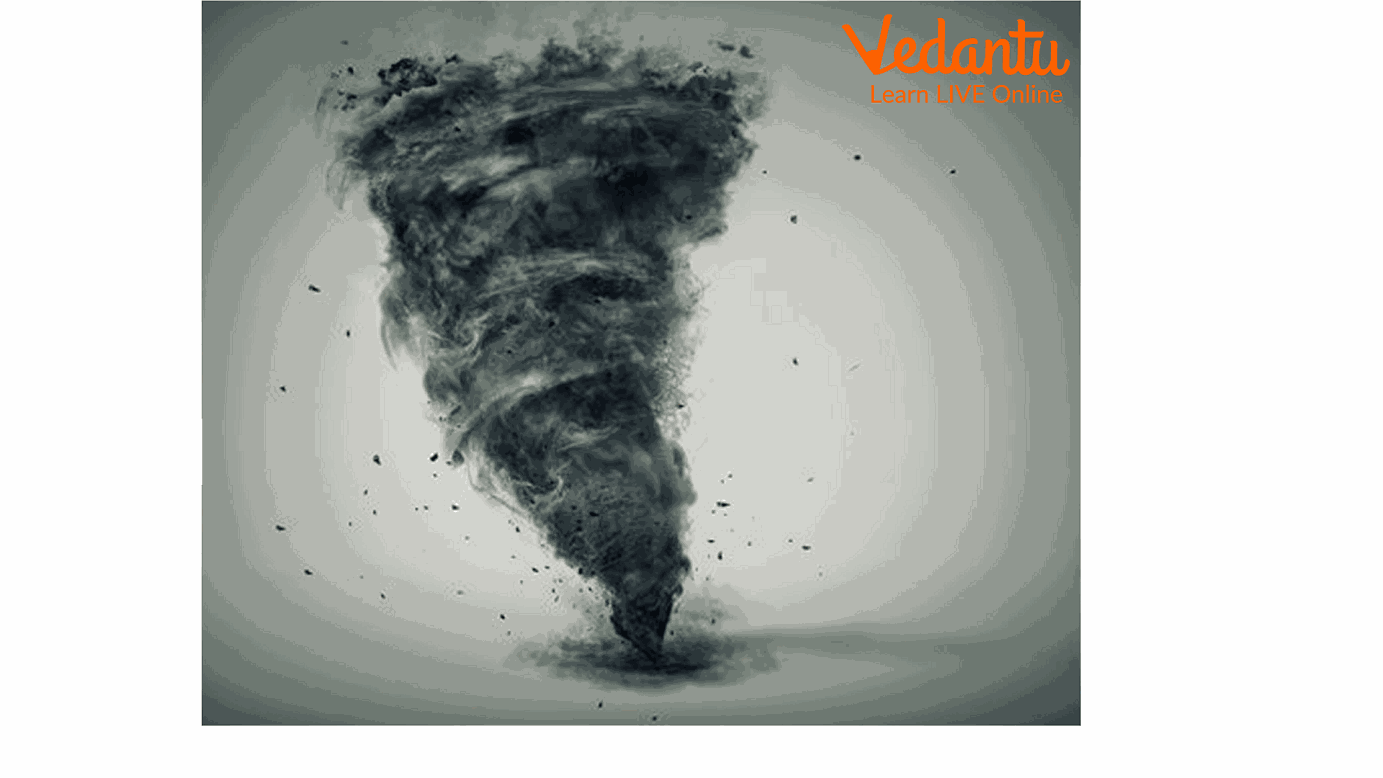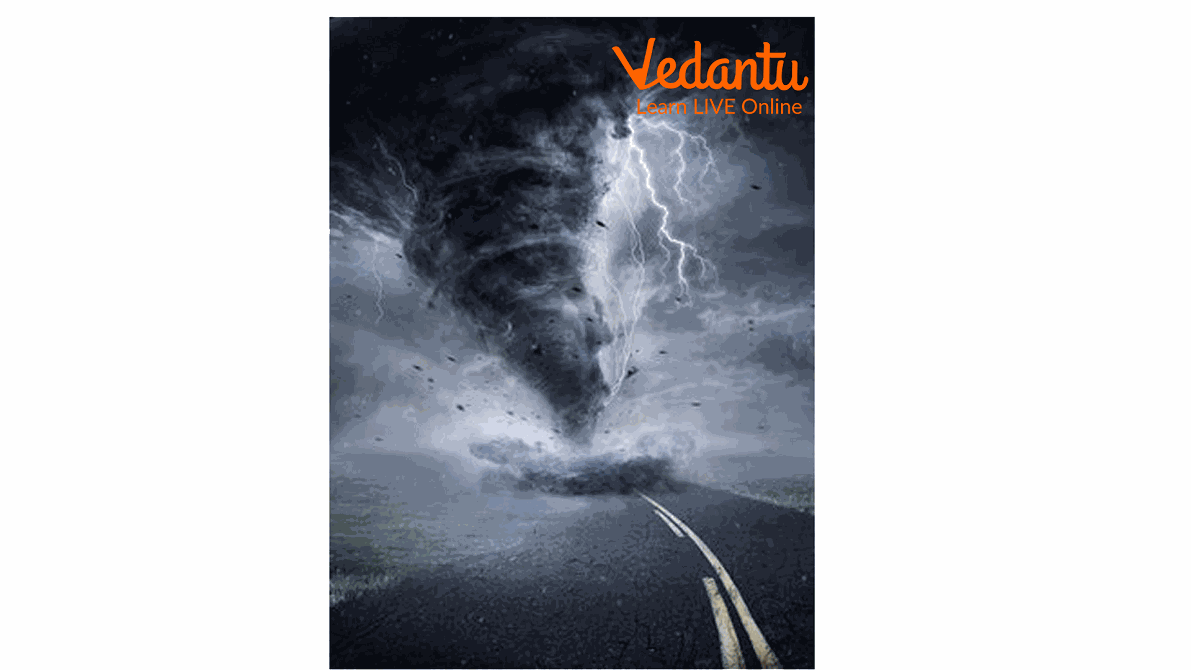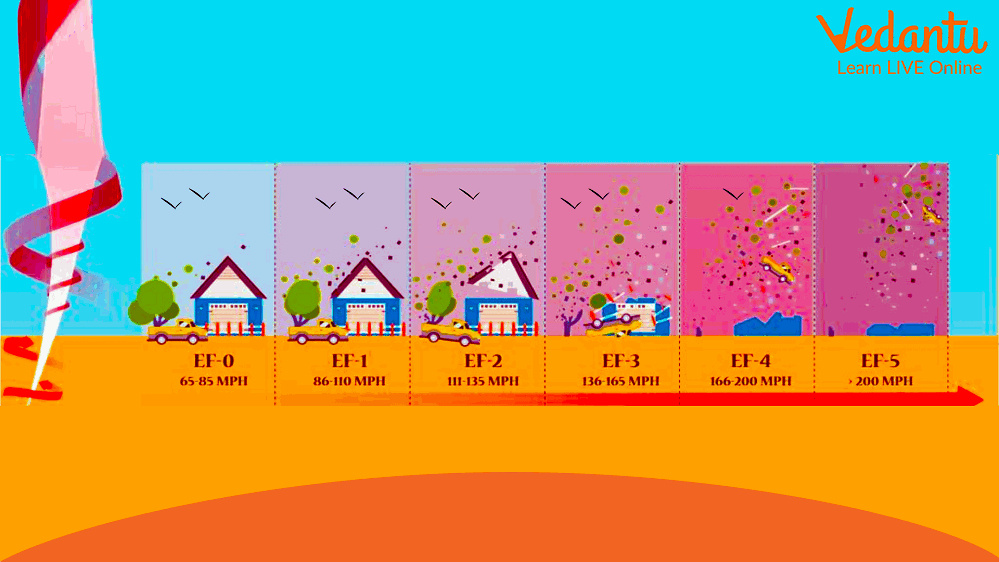




What Are the Different Shapes of Tornadoes?
Tornadoes are storms in which powerful rotating winds form a column that extends from a cloud to the ground. Tornado winds are the strongest on Earth. They have top speeds of up to 300 miles per hour (500 kilometers per hour). High winds can flatten buildings and propel heavy objects into the air, such as cars. However, most tornadoes are brief and cause minor damage.

Running away from Tornado
Tornado Features
The whirling winds of a tornado are visible due to water droplets in the air. A funnel cloud is a visible column. A funnel cloud can take the form of a cone, pillar, or tube. It can range in width from a few feet to hundreds of feet. In the Northern Hemisphere, winds usually blow counterclockwise, while in the Southern Hemisphere, winds blow clockwise.
Once a tornado touches the floor, it travels across the land at about 28 miles (45 kilometres) per hour. As a result, tornadoes typically move west to east. Tornadoes are typically only two or three minutes long. However, tornadoes can last for 15 minutes or more.

Tornadoes - Spinning Thunderstorms
Types of Tornadoes
A supercell is a large, long-lasting thunderstorm. It is capable of forming some of the most powerful and violent tornadoes.
A waterspout is a spout that forms over water. When they hit land, they usually dissipate.
A landspout is similar to a waterspout, but it is on land. Therefore, it is weak and not associated with an air vortex from a thunderstorm.
Gustnado - A small tornado caused by wind gusts at a weather front.
A tornado with more than one spinning tube of air is known as multiple vortexes.

Example of Multi-vortex Tornadoes

Example of Waterspout Tornadoes
Tornado Safety
Meteorologists can forecast where and when tornadoes will form. When the weather conditions are favourable for a tornado, meteorologists issue a tornado alert. A tornado alert is issued when a tornado is spotted.
People should seek shelter in sturdy buildings if a tornado is approaching. The safest places are basements and rooms without windows. Mobile homes and automobiles do not provide adequate protection. If a person is caught outside, they should stay close to the ground, preferably in a ditch.

Survive a Tornado
Interesting Facts about Tornadoes

Scale of 0 to 5, with F0 being Tornadoes
Tornadoes are even known as twisters, cyclones, and funnels.
A wind vortex must make contact with the ground to be officially designated as a tornado.
Over 1,000 tornadoes strike the United States each year, more than any other country.
Tornadoes have the fastest winds on the planet.
Don't expect to outrun a tornado; the average tornado travels at 30 miles per hour, but some can reach speeds of 70 miles per hour.
Summary
A violently spinning column of air that makes contact with the ground, usually at the base of a thunderstorm. Tornadoes are the most damaging storms in nature. Tornadoes, which are spawned by powerful thunderstorms, can kill people and devastate a neighbourhood in seconds. Tornado winds can get speeds of up to 300 miles per hour.
FAQs on Tornado Shapes: Types, Examples & Key Facts
1. What is a tornado?
A tornado is a violently rotating column of air that extends from a thunderstorm to the ground. It is often visible as a funnel-shaped cloud and is considered one of nature's most destructive storms due to its extremely high wind speeds.
2. How does a tornado form?
Tornadoes typically form within large thunderstorms called supercells. The process begins when warm, moist air rises and cool, dry air sinks, creating a rotating horizontal column of air. If this column is caught in the storm's updraft, it can be tilted vertically, forming a funnel cloud that becomes a tornado once it touches the ground.
3. What are the common shapes of tornadoes?
Tornadoes can appear in various shapes and sizes, which often gives clues about their lifecycle or intensity. The most common shapes include:
- Cone: A classic, smooth-sided funnel shape that is wider at the top and narrow where it touches the ground.
- Wedge: A very large and destructive tornado that appears as wide, or even wider, than it is tall, resembling a wedge stuck into the ground.
- Rope: A thin, snake-like tornado that often appears during the final stages of a tornado's life cycle as it weakens.
- Multi-vortex: A large tornado that contains several smaller, individual funnels rotating around a common centre.
4. Why do tornadoes have a funnel shape?
The characteristic funnel shape of a tornado is formed by a combination of factors. The rapidly rotating air column has very low pressure at its centre. This low pressure causes water vapour in the air to cool and condense, forming a visible cloud—the funnel. The shape is also defined by dust, dirt, and debris lifted from the ground, which makes the rotating column even more visible.
5. What are the safety measures to take during a tornado?
If a tornado warning is issued, you must take shelter immediately. The safest place is a basement, storm cellar, or an interior room on the lowest floor without windows, like a bathroom or closet. Get under a sturdy piece of furniture and cover your head and neck with your arms. If you are outdoors, lie flat in a ditch or a low-lying area away from trees and cars.
6. How are tornadoes measured or classified?
Tornadoes are classified based on the damage they cause, using the Enhanced Fujita (EF) Scale. The scale ranges from EF0 (light damage) to EF5 (incredible damage). Meteorologists assess the destruction to buildings and the environment to estimate the tornado's wind speed and assign it an EF rating.
7. How does the shape of a tornado relate to its strength?
While not a perfect rule, a tornado's shape can often indicate its intensity. Rope tornadoes are typically weaker and often signal that the tornado is dissipating. In contrast, large wedge tornadoes are frequently very powerful and destructive because their wide base can cause damage across a large path. However, any tornado, regardless of its shape, must be considered extremely dangerous.
8. What is the difference between a tornado and a cyclone?
While both are rotating storms, they differ in formation and scale. A tornado is a small, violent vortex that forms over land from a single powerful thunderstorm. A cyclone (or hurricane) is a massive storm system that forms over warm ocean waters and can be hundreds of kilometres wide. A tornado is a much smaller, more concentrated storm.
9. Can a tornado form over water?
Yes, when a tornado or a similar rotating column of air forms over a body of water, it is called a waterspout. Tornadic waterspouts are formed from severe thunderstorms and are just as dangerous as land-based tornadoes. There are also 'fair-weather' waterspouts, which are generally less severe and not associated with thunderstorms.
10. What are some other names for a tornado?
Tornadoes are commonly known by other names based on their appearance or nature. The most frequent alternative names are twister and funnel. These terms are often used interchangeably with 'tornado' to describe the same weather phenomenon.









